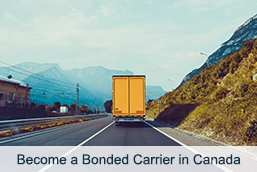 Do you know if you are eligible to be a bonded carrier in Canada? Do you know what the difference is between a non-bonded and bonder carrier? Not to worry – this article will give you everything you need to know about the difference, and what you need to become a bonded carrier within Canada.
Do you know if you are eligible to be a bonded carrier in Canada? Do you know what the difference is between a non-bonded and bonder carrier? Not to worry – this article will give you everything you need to know about the difference, and what you need to become a bonded carrier within Canada.
So, what’s the difference?
A non-bonded carrier must release all shipments are the first point of arrival (FPOA) in Canada, so a secondary carrier will pick up the goods at the border (once they’ve cleared customs) and will deliver them to the appropriate destination within Canada. A bonded carrier can deliver goods beyond the FPOA in Canada, and between destinations within Canada. Often a bonded carrier must be able to post a financial security with CBSA.
How do I apply to become a bonded carrier?
In order to become a bonded carrier, there are forms you will need to fill out and submit to the CBSA. To start with you will need to obtain and fill out the appropriate form (depending whether you’re sending goods via air, rail or freight). Next you’ll need to be able to provide proof of ownership and fill out the D120 Customs Bond. Once you have all the documentation in place, it will need to be sent to the Commercial Registration Unit at the Canada Border Services Agency in Ottawa, Ontario.
What do I do with the D120 form?
An original copy of the D120 customs bond must be submitted to the CBSA, and must be signed by the owner, president, CEO or other highest ranking official authorized person of a company. The bond must be completed by the surety company that is securing the bond. The form will indicate what your bond amounts are, whether your bond is to be a continuous bond or for only a specified period of time and the company’s/individual’s information. Finally it will have the embossed seal of the surety company.
I have my carrier/freight forwarder code, now what?
Once you receive your code from the CBSA, you’ll need to apply to transmit ACI to the CBSA and then begin the testing process.
What if I just need a bond for one trip?
If a non-bonded carrier requires a bond for a one time use, they can apply for a single trip authorization. An example of this may be if the non-bonded carrier cannot release the shipment at the FPOA in Canada and must bring it to another CBSA office further inland in Canada. In this instance, the carrier can apply for a single trip bond at the first point of arrival in Canada. A carrier can do this in one of two ways: posting a security at the CBSA office or by engaging a customs broker.
If you have any questions about your bond information, or not sure exactly how to obtain one the CBSA offices in Ontario can help with you to understand the forms, regulations and obligations of being a bonded carrier.


